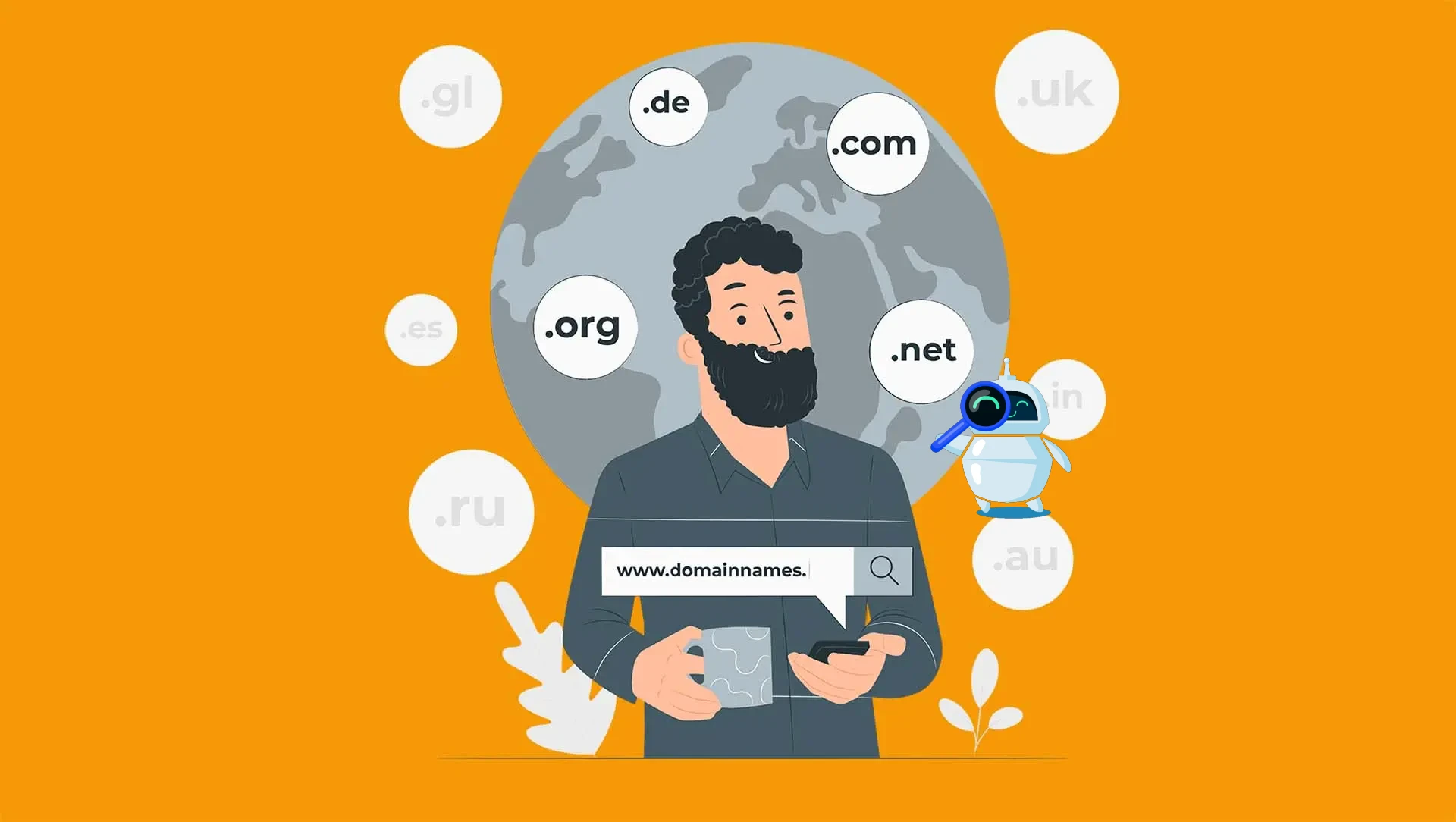What Is a Top Level Domain? TLDs Explained
11-08-2023 - BlogsWhat Is a Top Level Domain?
Have you ever looked at a website address and noticed the “.com” or “.org” at the very end? That’s called a top-level domain, or TLD for short. If you’re wondering, “what is a top level domain?” – it’s simple! It’s the letter combo that is just behind the domain name. Let’s say you stumble upon “www.cozyreads.books”. That “.books” at the end is the top-level domain. It tells you that this corner of the internet is probably a haven for book lovers – if you wanna boil it down, thats the easyanswer to the question to, “what are top level domains?”.
There’s a bunch of these top level domains, and the top level domain list – is only growing day by day. Currently the top level domain list holds a bit over 1500 different top level domains
These TLDs aren’t just fancy add-ons; they give people clues about your site. Picking one is like choosing the right hat for the right occasion. Maybe you’ll feel at home in the world of “.com”, or you want to show off a tech-edge with a “.io” top level domain.
What is an example of a Top level domain
When you’re typing a web address into your browser, you might not give much thought to what comes after the last dot. So, what is a top-level domain, in more everyday terms? It’s the part of a web address that labels a site’s identity or sometimes its connection to a country – depending on the chosen top level domain

Now, what is an example of a top level domain? Let’s take “.com” – The “.com” top-level domain (TLD) is by far the most recognized and widely used TLD on the internet, synonymous with the commercial intent of websites bearing this hallmark. What is a top-level domain like “.com”? It’s a universal badge that was originally intended for commercial entities when it was introduced back in the 1980s. Since then, the “.com” TLD has grown beyond its commercial origins to become the go-to extension for various types of websites, embodying reliability and recognizability. It has cemented its place as a cornerstone of the digital space, representing established presence and trust in the vast online landscape.
How Many Top-Level Domain Names in ICANN are there
ICANN oversees a broad and dynamic list of top-level domains, catering to a variety of needs and interests. The current count of these domains exceeds 1,500, reflecting the diverse and ever-expanding nature of the internet. This extensive catalog includes the traditional domains such as “.com,” “.org,” and “.net,” as well as a multitude of new additions that provide users with a greater range of choices for personalization and branding.
These domains are maintained and periodically updated by ICANN, ensuring that the directory of options available reflects the evolving digital landscape. From specialized fields to regional identifications, the assortment of top-level domains is designed to help individuals, businesses, and organizations establish a distinctive online presence.
To get a sense of the variety available in the top-level domain list, one can look at the more specific or niche options that have emerged, like “.photography” for photographers or “.academy” for educational institutions. With this expansive selection, registrants are bound to find a domain that perfectly aligns with their website’s purpose or their entity’s identity.
Types of Top-Level Domains
ICANN, the Internet Corporation for Assigned Names and Numbers, is responsible for overseeing the Internet Assigned Numbers Authority (IANA). The IANA plays an important role in managing and distributing domain names. To ensure organization and structure, the IANA categorizes top-level domains into six primary types:
Generic Top-Level Domains (gTLD)
Domains with generic top-level extensions encompass three or more characters and can be registered by anyone. Some of the widely recognized gTLDs are: .com, .net and .org
Even though termed as ‘generic’, these TLDs can convey specific insights about a website. For instance, a .net domain is commonly associated with network-centric sites, while .org often signifies an organization. There’s an increasing trend among corporates to customize their gTLDs further, by including the top-level domain as part of the domain name – f.x buy.now.
Since 2011, established organizations and firms have been permitted to apply for and register unique gTLDs. This led to the emergence of exclusive TLDs like: .google, .amazon and .apple
In 2014, a new category known as geographic top-level domains (geoTLD) was introduced. These are designed to affiliate websites with a geographical, geopolitical, ethnic, linguistic, or cultural group. While geoTLDs are region-centric, they fall under the gTLD category due to the unrestricted registration process. Here are a few examples of geoTLDs: .berlin, .amsterdam and .paris.
There are 1592 generic top-level domains available as of Saturday. September 9, 2023
Generic-Restricted Top-Level Domains (grTLD)
Generic-restricted top-level domains (grTLDs) have similarities with gTLDs but come with specific restrictions for their utilization. Registration of such domains necessitates the submission of proof of eligibility as per IANA requirements. The various grTLDs include: .biz, .name and .pro. For instance, .biz grTLD is strictly for authentic business or commercial purposes. Therefore, routine blogs or affiliate sites might not qualify for it.
Sponsored Top-Level Domains (sTLD)
Sponsored top-level domains are special TLDs that are backed by private businesses or institutions. These domains are specified for communities and organizations that have particular criteria and shared interests, such as corporate entities or federal agencies. The supervising organizations maintain authority over qualification guidelines. Examples of these sTLDs are: .gov, .museum, .edu, and .mil (specific to U.S. military)
Like generic top-level domains, sTLDs also offer valuable insights about the websites and their affiliated sectors. For instance, .edu is exclusively for accredited educational bodies in the U.S., while .gov is indicative of U.S. federal government websites. Sites employing sTLDs facilitate users in swiftly determining authorized info and are largely viewed as trustworthy.
To avail an sTLD for your own website, you are required to submit a request with a registrar accredited by ICANN, ensuring you fulfill the pertinent qualifications. Currently, a total of just 14 sponsored top-level domains are enlisted in the IANA catalogue.
Country-Code Top-Level Domains (ccTLD)
Country-code top-level domains, or ccTLDs, are reserved dual-letter extensions for countries, self-governing states, and territories. Websites and organizations associated with respective countries or territories can use ccTLDs, as well as enterprises operating within those regions.
Employing a ccTLD can tell customers which country the business is situated in and caters to. Furthermore, Google utilizes ccTLDs to geotarget your website for more precise search results. Nonetheless, ccTLDs specifically target countries and territories, not languages. For International SEO and multilingual websites, more than a simple ccTLD is necessary. Some prevalent ccTLDs: .ca (Canada), .br (Brazil), .de (Germany), .fr (France), .ie (Ireland), .in (India), .uk (United Kingdom), .us (United States)
In the past few years, ccTLDs have been used for more than location indications: they are now part of the website’s branding. For instance, .io is a frequently used ccTLD in the tech sector, while .ly (Libya) and .es (Spain) are often employed to construct optimized domain names, like Apple’s itun.es. Taking note of this growing trend, Google has started recognizing certain ccTLDs as gTLDs.
Test Top-Level Domains (tTLD)
Test top-level domains, also known as tTLDs, are distinct set of domains and TLDs, reserved specifically for development and testing aims. These specific domains cannot be officially registered with the Domain Name System (DNS). This provides the advantage of being able to explore and test software modifications without the worry of clashing with an existing or upcoming domain name. Mainly, tTLDs are deployed for internal development operations and documentation.
There are four primary tTLDs that are used: .test, .example, .invalid and .localhost
Infrastructure Top-Level Domain
The structure of an upper-level domain comprises of one unique TLD: the Address and Routing Parameter Area (ARPA, or .arpa). In reality, .arpa was the inaugural top-level domain to be established. Its registration as a TLD is disallowed because it’s usually employed for purposes associated with internet infrastructure.
Do Top-Level Domains Affect SEO?
The short answer is, Yes – TLDs can have an influence on your SEO as well as your overall marketing performance. Nonetheless, it’s worth noting that TLDs are less critical compared to on-page SEO elements, the quality of backlinks, and other marketing considerations. Google has reassured that using a custom TLD with targeted keywords does not confer any special advantage or disadvantage for search results.
However, even though TLDs don’t directly influence your Google rankings, they can shape people’s perception of your brand – trust is key in this context. From the viewpoint of users, some TLDs appear more reputable than others. For instance, a research from 2022 reveals that .com and .org are among the most trusted TLDs for websites.
If users deem your TLD more credible, they are likelier to select your website from search results – rather then untruest worthy websites. Hence, a generic TLD such as .com (or the ccTLD of your country) might attract more organic traffic than a less popular TLD.
Users are thus inclined to click on links, among the search results, that they consider trustworthy
So is a .com TLD really more trustworthy than other widely used TLDs like .co, .net or .io? growthbadger.com tried to answer this back in 2022, by doing an extensive experiment involving no less than 1500 participants – all of whom helped create a “Trust Rating” on a scale of 1 to 5, for the most used TLDs
Trust Rating (1-5)

Memorability Rating

Another crucial aspect when considering registering a new domain is how easy it is to remember the domain’s TLD. So they looked in the 2022 study, they also looked at whether specific TLDs are easier to remember than others.
And again, it was very clear that .com domain extensions are easier to remember, taking the lead with a recall score of 44%.
With a second place going to the .co TLD, but with a significant drop in how difficult people think it was to remember. A quarter of people had a harder time remembering a .co TLD than a .com – which is quite remarkable.
And if you then look at any of the other international TLDs such as .net and .org respectively – you see an even greater drop in people who had trouble remembering these TLDs
But interestingly enough, people had a relatively easy time remembering the .biz TLD – despite it being a TLD that you don’t normally see used. In fact, it was far better than both .us, .io, .net and .blog – all of which are the international TLDs that were hardest for people to remember.
However, this is understandable given that our memory works primarily through mental categorization. Since .com is the more widely used TLD, .net is often mistakenly remembered as .com.
Shady TLDs
Like that your domain’s TLD may influence user perception of its credibility, potentially increasing the likelihood of clicks on your site in search results. The same is also true when looking at TLD’s determined to be shady This suggests that standard generic top-level domains such as .com could yield more organic traffic than a less known TLD. Additionally, this can influence other avenues as well, since users are inclined to click on links they view as reliable, not just in the search engine results.
| Rank | TLD |
| 1 | .country |
| 2 | .stream |
| 3 | .download |
| 4 | .xin |
| 5 | .gdn |
| 6 | .racing |
| 7 | .jetzt |
| 8 | .win |
| 9 | .bid |
| 10 | .vip |
| 11 | ,ren |
| 12 | .kim |
| 13 | .load |
| 14 | .mom |
| 15 | .party |
| 16 | .review |
| 17 | .trade |
| 18 | .date |
| 19 | .wang |
| 20 | .accountants |
Although Top-Level Domains (TLDs) can potentially influence your Search Engine Optimization (SEO) efforts and overall marketing efficiency, the crucial factor is selecting a TLD that truthfully represents your business and its objective. By doing so, you will exude authenticity and build trust among your users.
Choosing the Optimal TLD for Your Website and Your Audience
Choosing the optimal Top-Level Domain (TLD) for your website and audience is a critical task that should be given due diligence. Essentially, TLDs refer to the last part of a domain name following the final dot. Popular examples include .com, .org, .net, among others. Your choice of TLD can impact both your search engine rankings and online visibility, forming a crucial part in establishing your brand’s digital presence.
Firstly, know your audience. Understanding who your website’s visitors are going to be is the first step towards selecting a perfect TLD. For instance, if your target audience is business-oriented, a .com or .biz TLD may be best suited. On the other hand, for non-profit organizations, a .org TLD could be the better choice.
Secondly, consider your geographical focus. Localized TLDs, like .us for the United States, .ca for Canada, or .uk for the United Kingdom, may improve your site’s search engine rankings in those specific regions. Coupling a geographic TLD with local SEO strategies could potentially skyrocket your website’s visibility in local search results.
It’s also worth considering alternative and new TLDs. While .com is often the default choice, alternative TLDs can be great for niches and may capture attention. They offer more availability, allowing for creativity in domain names. Some examples include .blog for bloggers, .photography for photographers, or .tech for tech startups.
Despite the value brought by these TLDs, bear in mind that Google treats most TLDs the same in terms of SEO. Their algorithms focus more on website content, mobile friendliness, and loading speed. Nonetheless, your TLD choice can still have indirect impacts on your site’s SEO performance. It affects users’ perception and click-through rates, and thus, the overall site traffic, playing a crucial role in driving online success.
In conclusion, selecting an optimal TLD is a blend of understanding your audience, considering geographical influence, exploring alternative options, and balancing these against SEO considerations. It’s about ensuring your TLD aligns with your brand, your audience’s expectations, and assists in promoting a successful and effective online presence.
Top Level Domain List by Popularity
If you’re curious about which web address endings are the most common, you’re looking for a “Top Level Domain List by Popularity.” This list ranks the TLDs according to how frequently they’re used across the internet. At the top of this Top Level Domain List, you’ll typically find “.com” reigning supreme, due to its global appeal and recognition as an online business staple.
Following close behind in popularity are “.net”, “.ru” and “.org”. While “.net” was originally intended for network providers, it’s been broadly adopted by various types of organizations and businesses. The “.org” extension is often associated with non-profits and charities but is open to anyone. Country-specific TLDs, such as “.uk” for the United Kingdom and “.de” for Germany, also make a strong showing on the list due to national pride and relevance.
Other TLDs gaining traction include “.info” for informational sites, “.biz” for businesses, and “.io” which has become a favorite within the tech industry. The positions on the Top Level Domain List can shift as new TLDs are introduced and internet trends change, offering a fascinating snapshot of the online world’s evolving preferences.
| Rank | TLD | Percentage of Websites Using TLD |
| 1 | .com | 49.2% |
| 2 | .org | 4.6% |
| 3 | .ru | 4.0% |
| 4 | .net | 3.0% |
| 5 | .de | 2.4% |
| 6 | .uk | 2.1% |
| 7 | .au | 1.7% |
| 8 | .fr | 1.6% |
| 9 | .in | 1.5% |
| 10 | .br | 1.4% |
| 11 | .jp | 1.4% |
| 12 | .it | 1.2% |
| 13 | .ir | 1.1% |
| 14 | .pl | 1.1% |
| 15 | .ca | 1.0% |
| 16 | .nl | 0.9% |
| 17 | .ua | 0.8% |
| 18 | .vn | 0.7% |
| 19 | .tr | 0.7% |
| 20 | .co | 0.7% |
| 21 | .cr | 0.6% |
| 22 | .es | 0.6% |
| 23 | .gr | 0.5% |
| 24 | .ch | 0.5% |
| 25 | .info | 0.5% |
| 26 | .cn | 0.5% |
| 27 | .eu | 0.5% |
| 28 | .za | 0.5% |
| 29 | .io | 0.5% |
| 30 | .il | 0.5% |
